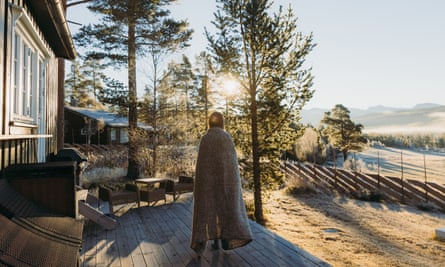Outdoor saunas, freezing cold and remote huts: how Scotland fell in love with Scandinavian winters
TThe sun shines over the water outside the sauna – it looks inviting, even though it is clearly freezing. But it's only a short dip, and then the bikini-clad swimmers are back in the enveloping warmth of the caramel-scented wooden hut a few meters away on the shore, with giant windows offering sweeping views of the distant hills.
This is Scandinavian winter life par excellence: but it's not a Norwegian fjord or Swedish forest – it's the shores of Loch Fyne on the west coast of Scotland. This is one of a growing number of Scandinavian-style outdoor saunas along the coastline where locals and visitors gather during the long, dark northern winter days in search of company and warmth, and to improve their physical and mental health.
“They do so well in winter in Scandinavia – they find ways to really enjoy it – and now we're doing the same in Scotland,” says Hailey O'Hara, a member of the family that runs West Coast Wellness, the owners of this sauna. .
“In the past, there was actually only the pub where people could get together in the winter, and that's nice, but a sauna gives a different kind of atmosphere.”
And, says her sister-in-law Rosie Barge, like all the best Scandinavian winter traditions, this one is well prepared for bad weather. “It's beautiful today, but in some ways it's almost better when it's storming – you get such a buzz. And the atmosphere in the sauna is really cozy. There is no pressure: you can have a chat or just look at the landscape.”
The sauna here was a result of the lockdown, when the extended Barge family returned to their farm in Otter Ferry and realized how much they enjoyed their dip in the lake. “We bought two caravans from a farm in Aberdeen and turned them into a sauna for up to 16 people,” says Rosie.
There are regular community sessions, and it's the same across the country on the banks of the Moray Firth at Watershed Sauna, where Elle Adams and Rupert Hutchinson transformed an old horse trailer using a Finnish wood-burning stove. “We like to swim here, but in winter it is so cold and dark. We thought, 'Wouldn't a sauna be great?' When we opened it here on the beach in November 2022, everyone wanted to try it out, and it's now very popular and a thriving business. It means the beach is fun in all weathers and is a brilliant way to connect people with nature.”
Adams and Hutchinson spent time in Norway and saw how winter is celebrated there. Scotland's ties with the Scandinavian countries across the North Sea, with which it has so much in common in terms of geography, climate and culture, are increasingly being marked in other ways.

Coorie, the Scottish equivalent of the Danish hygge, embraces the sense that winter isn't something to be survived or endured – it's a time to shift gears, focus inward and recharge. Glasgow interior designer Anna Campbell-Jones, BBC judge Scotland's House of the Year, says Coorie culture has become more apparent in recent years, as have elements of Scandinavian design. “People are building their own homes in beautiful rural locations, creating large spaces with large windows so there is a direct connection to the outdoors.” She has also noticed a big increase in outdoor pools that can be used all year round: “People are installing them so they can run out into the cold or snow and enjoy the natural environment.”
Another Scandinavian tradition that is becoming increasingly popular in Scotland is hutting: owning or renting a hut, often in a remote part of the countryside, to which you retreat at the weekend for a taste of a simpler way of life. Campbell-Jones has one on an island in the Hebrides. “You can only get there by boat, and once you get there, all you have is what you brought with you: there is no electricity, running water and no cell phone signal,” she says. “This way you reconnect with nature and also with the people around you, and you make your own fun.”
It's a pushback, she says, against the idea that entertainment should come from the latest must-see streaming drama, or that we should define ourselves by what happens on social media or with other people. “We've forgotten how to just 'be' with each other, and this is about resetting that.”
Culturally, the connections between Scandinavia and Scotland are being celebrated more than ever: a November conference called Partners in Crime, organized by the Scottish Society for Northern Studies, explored the literary cross-currents between Scotland and Scandinavia through crime fiction, and the two-week Celtic The Connections music festival in Glasgow, which starts on January 18, has a Norwegian link. Its creative producer, Donald Shaw, says he is often struck by the similarities.
“When folk musicians talk about inspiration, they often talk about landscape and climate. You will find much that is similar in Scandinavian and Scottish folk music. The violin tradition is strong in both areas and there is a sense of community: people come together, especially on dark winter evenings, and play music together.”
